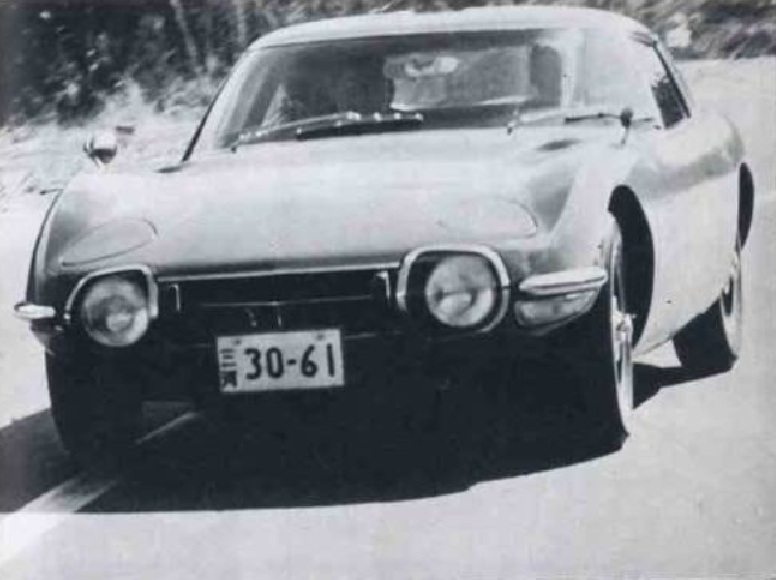Toyota 2000GT (1967)

Publication: Car Graphic
Format: Road Impressions (stub article - original cut off)
Date: July 1967
Author: “C/G Test Group” (uncredited)
Operation TNT007
In early February, “Operation TNT007” began across the Pacific Ocean.
As the first step in the full-scale introduction of the Toyota 2000GT in America, a 2000GT arrived on the West Coast and was registered with the California license plate number “TNT007.” TNT is an abbreviation for Trinitrotoluene, a high-performance explosive. Needless to say, 007 is the code name for the famous British spy James Bond. This was actually the first 2000GT registered in the United States.
At the same time, a certain famous car magazine carried out a secret reporting mission. As part of this mission, we visited Toyota’s headquarters in Toyota City, where we were given the opportunity to test drive Japan’s first full-scale Gran Turismo for a short time. Although the license plate number was different, the impression we got was indeed that of TNT and 007. The explosive performance when the throttle is fully opened is as intense as TNT, and the styling and roominess are excellent enough to satisfy even Bond, who has an eye for high-end GTs.
The test vehicle was the 10th model built at the Yamaha 2000GT factory in Hamamatsu. It was an export model, with gauges calibrated in miles rather than km, and we must point out that this car was one of a so-called “pilot production” batch that is not intended for sale on the market, and is still being used for development. When we test drove it, it was a new car with the odometer showing 800km. This car was painted a bright red that could be called fire engine red.
According to Toyota engineers, this car is being carefully looked after in the Chukyo area near Nagoya.
The concept of the 2000GT dates back to 1963-1964, and Toyota’s designers have not been swayed by the recent trend towards 2+2 GTs. It would be quite a challenge to add space for two extra seats in a car with such an extremely low and compact body, and a long inline six-cylinder engine related to mass-produced sedans, and according to Toyota’s engineers, there are no plans to make the 2000GT a 2+2 or +1 in the future.
European-sized interior
In its impression of the Corona 1600S Hardtop, the British magazine Motor wrote, “The Japanese, even with all of their great industrial and commercial talent, seem unable to grasp the fact that we Europeans are taller than they are.” This criticism certainly does not apply to the 2000GT. “There are a lot of people that size on the 2000GT design and development team,” says Chief Project Supervisor Jiro Kono (no classified specifications have been released). He himself is 180cm tall and weighs 80kg, cutting an imposing figure. Among the racing team, there are also large drivers such as Shihomi Hosoya. And their headquarters at Toyota’s modern technical center is certainly a very spacious and comfortable place to work. The international sensibilities of these European-sized people are well-reflected in the design and livability of the interior of the 2000GT.
The height of the 2000GT is 1,092mm, which is quite low for a front-engined car. For comparison, the height of the Porsche 911 is 1,330mm, the Alfa Romeo Z is 1,200mm, the Jaguar E-type is 1,219mm, and the Ferrari GTB is 1,345mm. Even though it is so low, it is extremely easy to get in and out of the 2000GT. The adoption of a backbone frame, like that of the Lotus Elan, allows the height of the door sills to be lowered to the bare minimum.
The seats are impeccable, being designed by a development team that has been involved in long-distance races and endurance record runs, and they provide excellent support for the upper and lower back. With 140mm of fore-and-aft adjustment, backrest angle adjustment, and 60mm telescopic adjustment for the steering wheel, you can find your preferred position, from straight arm, semi-reclined Jim Clark type to upright taxi-driver type. The interior is all black and covered in PVC, but it looks and feels very similar to genuine leather. The interior is explained in-depth in the February issue of this magazine, so we will not repeat the details here, but it is worth noting that the interior is uniquely well-designed and well-constructed.
Visibility from the cockpit to the front and sides is good. The raised edges of the front fenders help give a sense of the width of the car, but as with any fastback this big, rear visibility is limited. The rear window has a strange lensing effect that made the accompanying Corona sedan look like a low-slung sports car in the rearview mirror; the limited visibility out the back window is compensated for by two racing-type fender mirrors.
TNT performance
The acceleration performance of the 2000GT at full throttle can only be described as explosive. The official 0-400m acceleration time is 15.6 seconds, but unofficially, it is said to be capable of 0-400m times just under 15 seconds, so it can compete on equal terms with the Ferrari GTS and the Porsche 911S. The test car had the standard 4.38 final drive ratio; the acceleration of the 2000GT with the optional 4.63 final drive is sure to be incredible. Since the test car was a completely new car, we did not attempt hard acceleration tests like the 0-400m run ourselves, but even half-throttle acceleration on the highway was impressive. The tachometer’s yellow zone starts at 6800rpm and goes into the red at 7500rpm. Apart from a few brief instances where it exceeded 6500rpm, we limited the revs to 5000rpm at most, but the increase in rotation was smooth. The early Solex PHH type carburetors suffered shortness of breath at high revolutions, but recent models seem to have completely cured this problem.
(Original article cut off below this point)